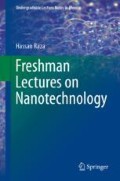Abstract
Photonics is the study of light-matter interaction, where photons interact with electrons and vice versa. More specifically, Nanophotonics is, the science and engineering of light matter interactions that take place on wavelength and subwavelength scales where the physical, chemical or structural nature of natural or artificial nanostructured matter controls the interactions.
Access this chapter
Tax calculation will be finalised at checkout
Purchases are for personal use only
Notes
- 1.
This process may also be referred to as elastic scattering.
References
Vukusic et al., Proc R Soc Lond [Biol], 266 (1999)
Zi et al., Proc Natl Acad Sci 100, 12576 (2003)
Author information
Authors and Affiliations
Corresponding author
Appendices
Problems
8.1 Describe the cortex structure in the peacock’s feather barbules and explain how does it get its striking color pattern.
8.2 Describe the butterfly wing structure and explain how does it get its striking color pattern.
8.3 Comment on the material, spacing and photonic band gap of a photonic crystal of your choice.
8.4 What is the wavelength of the photons being used in optical fiber communication? What is the reason behind this specific wavelength? Which materials are used for making sources and detectors in optical fiber communication and why?
8.5 Comment on the cloaking application of a meta-material of your choice.
8.6 What is a super lens? How nanophotonics is helping in this regard?
8.7 For an electron microscope, \(\lambda = 1\) nm, \(NA = 0.05\), what is the resolution?
8.8 How can the resolution of a microscope be improved in context of the wavelength being used?
8.9 How can the resolution of a microscope be improved in context of the numerical aperture being used?
8.10 Give an example of molecular photonics inspired application.
Research Assignment
R8.1 Energy related applications impacted by nanotechnology include solar cells, solar thermal, thermoelectric, batteries, wind energy, sensors, etc. Pick a topic of your choice about how nanotechnology is helping us cope with the ever increasing energy demand, and write a one-page summary.
Rights and permissions
Copyright information
© 2019 Springer Nature Switzerland AG
About this chapter
Cite this chapter
Raza, H. (2019). Nanophotonics. In: Freshman Lectures on Nanotechnology. Undergraduate Lecture Notes in Physics. Springer, Cham. https://doi.org/10.1007/978-3-030-11733-7_8
Download citation
DOI: https://doi.org/10.1007/978-3-030-11733-7_8
Published:
Publisher Name: Springer, Cham
Print ISBN: 978-3-030-11731-3
Online ISBN: 978-3-030-11733-7
eBook Packages: Physics and AstronomyPhysics and Astronomy (R0)

